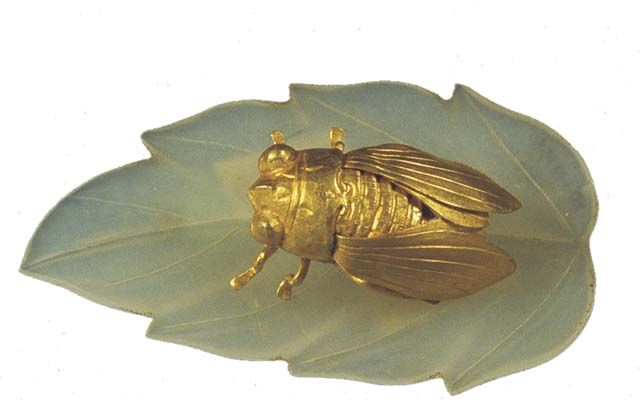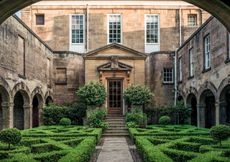Exhibition: The Ming Dynasty in Edinburgh and China
Two exhibitions this year, in Edinburgh and London, illustrate the visual splendour of the Ming Dynasty


When that well-known member of the Drones Club Monty Bodkin had to describe a look of outrage prompted by an unfortunate social encounter, he recalled that he ‘had not seen anything like it since the day, years ago, when his Uncle Percy, who collected old china, had come into the drawing-room and found him balancing a Ming vase on his chin’.
This joke by P. G. Wodehouse may seem far removed from the formidable scholarship that has brought us two magnificent exhibitions on Ming culture, at the National Museum of Scotland and the British Museum, but it raises a point that intrigues Prof Craig Clunas, one of the curators of the London exhibition: ‘No one has yet tracked the process whereby a “Ming vase”… came to be in English the abiding simile for something precious and fragile and frivolous in equal measure.’
One answer to that goes to the heart of why these shows are so significant. Like last year’s breathtaking exhibition of Chinese painting at the V&A, both ‘Ming: The Golden Empire’ in Edinburgh and ‘Ming: 50 Years that Changed China’ in London challenge the old, but still very much alive, Western perception of classical Chinese civilisation as exotically rarified ‘precious’ in every sense and, at heart, frivolous or decadent.
Such ideas suited 19th-century European imperialists, who promoted the belief that Chinese civilisation had barely changed over 30 centuries. In fact, the Ming dynasty, which lasted from 1368 to 1644, witnessed major transformations, of which the most celebrated are the establishment of Beijing as the capital and therefore Mandarin as China’s main language and the creation of an efficient civil service, chosen by competitive examination.
The blue-and-white porcelain that includes the vessels known to the West as ‘Ming vases’ was arguably the first truly international brand, coveted across Europe as well as Asia. It was the product of a society that was highly centralised, urbanised, militaristic and keenly interested in extending the Chinese sphere of influence: the porcelain may have been breakable, but there was very little that was fragile about the Ming.
The dynasty was founded by Zhu Yuanzhang (1328–98), a warlord of humble origins who exploited the void left by the collapse of the vast Mongol empire following the death of Genghis Khan a century before. Zhu’s overthrow of the Mongol Yuan dynasty returned China to native rule for the first time in nearly 250 years. Most earlier Chinese dynasties Tang, Song had been named after places, but Zhu gave his new dynasty a descriptive title.
Sign up for the Country Life Newsletter
Exquisite houses, the beauty of Nature, and how to get the most from your life, straight to your inbox.
The reason why he chose ‘Ming’, usually translated as ‘bright’ or ‘shining’, is a matter of scholarly dispute, but it is widely accepted that the term probably had some religious significance and may be related to Zhu’s Buddhist beliefs.
As Prof Clunas has emphasised, it is striking that a dynasty so celebrated for its patronage of art should have adopted a name that evokes a visual quality.
‘Brightness’ must have seemed an appropriate name for the Ming Court, which, by an imperial edict of 1403, reserved to itself the right to wear yellow silk and gold embroidery: every portrait of the early Ming emperors depicts them in their yellow official robes, decorated with dragons.
This visual splendour is evoked in the diary of the artist Ghiyath al-Din, who, in 1420, accom-panied a diplomatic mission from the Timurid ruler Shahrukh to the Court at Beijing, which he described as ‘a city of inordinate magnitude, made all of stone’. He was astonished by the magnificence of the imperial interiors: their pillars the colour of turmeric and their gilded furniture and yellow-silk textiles.
These two exhibitions allow us to glimpse something of the splendour that so impressed Ghiyath al-Din. The Edinburgh exhibition is drawn from the collections of the Nanjing Museum, which has lent a representative array of treasures while its building is being enlarged. With the Palace Museum in Beijing and the National Palace Museum in Taipei, the museum in Nanjing the Ming capital before the move to Beijing in 1421 possesses the principal survivors of the imperial collections of paintings, calligraphy and ceramics.
To these have been added some of the many discoveries made by archaeologists in the 20th century, of which few can be so enchanting as a gold cicada on a jade leaf found in the family tombs of an official named Zhang Anwan. Created in about 1500, it may be a visual pun, as the phrase ‘golden cicada on a jade leaf’ (Jinchan Yuye) sounds like a compliment paid to a woman for her incomparable beauty.
The British Museum exhibition focuses on the first half of the 15th century, when the Ming moved to Beijing and established the structure of imperial government that would long outlive them. It was a period dominated by two very different rulers, the Yongle Emperor (Chinese emperors were known by a title, never their family name Yongle means ‘Perpetual Happiness’), who, having come to the throne by a coup in 1402, established Ming rule on a firm military basis. Until his death in 1424, he sought to expand his influence by naval expeditions led by his famous admiral Zheng He, who journeyed on the Emperor’s behalf to the Middle East and East Africa.
The Yongle Emperor’s achievements were built upon by his grandson, the Xuande Emperor, who ruled from 1425 to 1435. A poet, artist and collector, he was one of the dynasty’s greatest patrons, and the breathtaking quality of the works with which he surrounded himself is evident in such rare survivors as a cloisonné enamel jar made to decorate a hall in one of his palaces. In works such as this the Ming shine now as brightly as they did 600 years ago.
‘Ming: The Golden Empire’ is at the National Museum of Scotland, Edinburgh, until October 19 (0300 123 6789; www.nms.ac.uk) ‘Ming: 50 Years that Changed China’ is at the British Museum, London WC1, September 18 January 5, 2015 (020–7323 8299; www.britishmuseum.org)
This article was originally published in Country Life, September 17, 2014
-
 Can't you hear me S.O.S? Our treasured native dog breeds are at risk of extinction
Can't you hear me S.O.S? Our treasured native dog breeds are at risk of extinctionDo you know your Kerry blue terrier from your Lancashire heeler? A simple lack of publicity is often to blame for some of the UK's native dog breeds flying dangerously low under-the-radar.
By Victoria Marston Published
-
 'There are architects and architects, but only one ARCHITECT': Sir Edwin Lutyens and the wartime Chancellor who helped launch his stellar career
'There are architects and architects, but only one ARCHITECT': Sir Edwin Lutyens and the wartime Chancellor who helped launch his stellar careerClive Aslet explores the relationship between Sir Edwin Lutyens and perhaps his most important private client, the politician and financier Reginald McKenna.
By Clive Aslet Published
